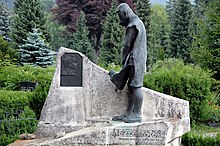Friedrich Gornik
Friedrich Gornik (born January 15, 1877 in Prävali ( Slovenia ), † March 26, 1943 in Vienna ) was an Austrian sculptor and craftsman .
Life
Friedrich Gornik attended a technical school in Villach before studying and working with Theodor Charlemont in Vienna for a year . Then (1897–1905) he studied at the Vienna School of Applied Arts , which he completed with a travel grant. At an exhibition in Villach in 1903 he presented his work, including ceramic depictions of animals, some for lighting fixtures, as well as designs for vases and bowls. Subsequently, Gornik created large animal figures in plaster, which were cast by other artists and which can be traced back to his own zoological studies in the Schönbrunn Zoo . A naturalistic group of horses, the Troika , was bought by Emperor Franz Joseph I and is now in the Kaiservilla in Bad Ischl .
On January 4, 1916, Gornik was accepted into the art group of the kuk war press quarter , where he was wrongly referred to as a war painter when he joined . In the works that he produced there during the First World War , primarily in the Italian theater of war , not only depictions of people but also his preference for the animal motif is evident. Together with other well-known artists from the war press quarter, he exhibited his works at the respective war exhibitions and in the Vienna Künstlerhaus in 1916, 1917 and 1918. Gornik continued to work partly in Vienna and partly in Carinthia before he died of a stroke on March 26, 1943 . He bequeathed his entomological collection to the Carinthian State Museum .
Gornik's work is of a high quality craftsmanship, paired with an understanding of the psychological and physical. Friedrich Gornik was a co-founder of the Carinthian Art Association , his works are now represented in several museums, including the Austrian Gallery Belvedere and the Museum of Military History .
Works (excerpt)
- Figure group Bosnian pack animal column, bronze, signed and dated "F.Gornik 1916", 13 × 52.5 × 26.5 cm; Army History Museum , Vienna
- Equestrian statuette Attacking Dragoons on Horseback , bronze, signed "Fried.Gornik", 52 × 14.5 × 41.5 cm; Army History Museum, Vienna
- Equestrian statuette Vedette , bronze, signed "Fried.Gornik", 40 × 14 × 47 cm; Army History Museum, Vienna
- Large sculpture of a Lesachtaler sunk in silent memory, tomb for the Viktringer song prince Thomas Koschat (1845–1914); Annabichler cemetery of the LH Klagenfurt / Carinthia.
literature
- Ilse Krumpöck: The sculptures in the Army History Museum. Vienna 2004, p. 56 f.
- Friedrich Gornik. In: Austrian Biographical Lexicon 1815–1950 (ÖBL). Volume 2, Verlag der Österreichischen Akademie der Wissenschaften, Vienna 1959, p. 33.
Individual evidence
- ^ Austrian Army Museum (ed.): Catalog of the war picture gallery of the Austrian Army Museum , Vienna 1923, p. 3
- ↑ Hans Kautz: Academ. Sculptor Friedrich Gornik †. In: Journal of the Austrian Entomologists Association. Volume 28, 1943, pp. 148–150 (Obituary, PDF (1.5 MB) on ZOBODAT , accessed on May 23, 2012).
- ↑ Ulrich Thieme , Felix Becker (Hrsg.): General Lexicon of Fine Artists from Antiquity to the Present . Leipzig 1921, Volume 14, p. 402
- ↑ Ilse Krumpöck: Die Bildwerke im Heeresgeschichtliches Museum , Vienna 2004, p. 56 f
- ↑ Friedrich Gornik ( memento of March 25, 2016 in the Internet Archive ) on digital.belvedere.at, accessed on May 23, 2012
- ↑ Johann Christoph Allmayer-Beck : The Army History Museum Vienna. Hall VI - The k. (U.) K. Army from 1867-1914. Vienna 1989, p. 22
Web links
| personal data | |
|---|---|
| SURNAME | Gornik, Friedrich |
| BRIEF DESCRIPTION | Austrian sculptor |
| DATE OF BIRTH | January 15, 1877 |
| PLACE OF BIRTH | Prevalje |
| DATE OF DEATH | March 26, 1943 |
| Place of death | Vienna |
